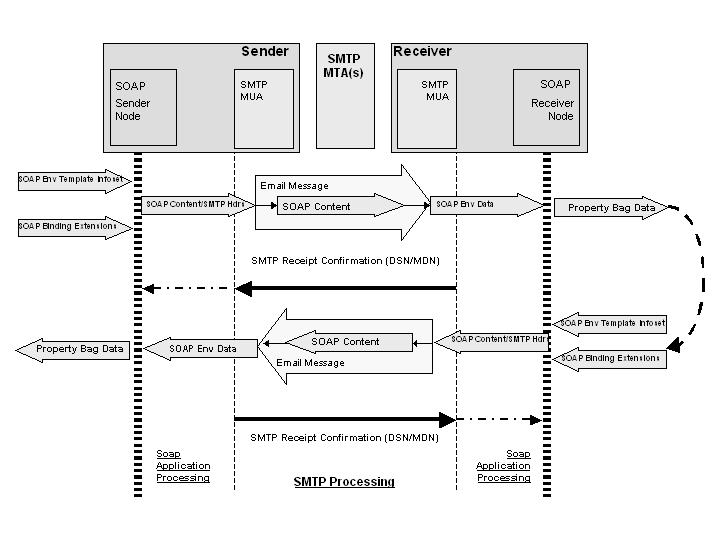- From: Mountain, Highland M <highland.m.mountain@intel.com>
- Date: Thu, 16 Aug 2001 11:33:58 -0700
- To: "XML Distributed Applications List (E-mail)" <xml-dist-app@w3.org>
- Message-ID: <ED492E16A0B8D311AC490090276D20840FA8771E@FMSMSX31>
> SMTP Sample Binding > <Henrik's Sample Binding Spec>SMTP is a stateful, relay based > client/server protocol designed for exchange of one-way messages. A > sender-SMTP establishes a two-way transmission channel to a receiver-SMTP. > The receiver-SMTP may be either the ultimate destination or an > intermediate. SMTP commands are generated by the sender-SMTP and sent to > the receiver-SMTP. SMTP replies are sent from the receiver-SMTP to the > sender-SMTP in response to the commands. SMTP is explicitly designed for > off-line scenarios based on a store-and-forward model with some implicitly > defined reliability quality of service defined by each > implementation.</Henrik's Sample Binding Spec> > > Diagram explanation > > Sending - Outgoing Message Processing > > At the sender, the mandatory properties need to be transformed into the > SMTP wire representation. This "on the wire" representation would include > the email message body, attachments and SMTP header information. In the > attached diagram, incoming data and implied processing are shown at each > SOAP/SMTP component. The sending SOAP node needs to have some notion of > the application envelope template. The content of the SOAP.Envelope is > constructed and passed to the "module" which adds the Transport Binding > SOAP header extensions to the SOAP Content. (see Issue #1 below) Any > necessary SMTP based header content is then wrapped around the SOAP > Content for "on the wire" transport (open issues - where is security, > encryption handled). > > Receiving - Incoming Messages > > The receiving SOAP node will receive the SOAP envelope data, which may > include SOAP Binding extension information as well as application specific > envelope template data. The receiving node must reconstruct this data as > specified in the Binding and SOAP Envelope Template. > > Responding to the Original Sender > > Note about Correlation > <Henrik's Sample Binding Spec>Because SMTP is fundamentally about the > exchange of one-way messages, message correlation is a higher layer > concept with no constraints from SMTP itself. For example, SMTP does not > require that related messages are returned to the same party that sent the > initial message nor imposes any time constraint on the delivery of related > messages. This is true even in the case of the presence of a "Reply-To" > header field in a message. > Correlation is done based on a message id and either a "In-Reply-To" of > "References" header field as defined by RFC 2822 > <http://rfc.net/rfc2822.html>. > Because message correlation is separate from the message exchange, there > is no way to recall or abort a message once it has entered the > system.</Henrik's Sample Binding Spec> > Responding to an original request using the In-Reply-To header will > inherently provide a tie back to the original request at the sender. A > response SOAP.Envelope template will provide a format for the response to > a given transaction. The SMTP content will then be assembled, as > specified under Sending - Outgoing Messages, prior to transport. > > > <<SMTP Binding Picture 815.jpg>> > > SMTP Issue 1 - We discussed having a separate ?.destination property for > the receiving SOAP Node and another property for the binding > specification. Did we decide to have 2 separate properties? I would vote > for 2. > SMTP Issue 2 - Where is security / encryption handled? > > > > Highland Mary Mountain > > Intel Corporation > eBusiness Solutions Lab > (480) 552 - 3817 > > highland.m.mountain@intel.com > >
Attachments
- image/jpeg attachment: SMTP_Binding_Picture_815.jpg

Received on Thursday, 16 August 2001 14:34:08 UTC